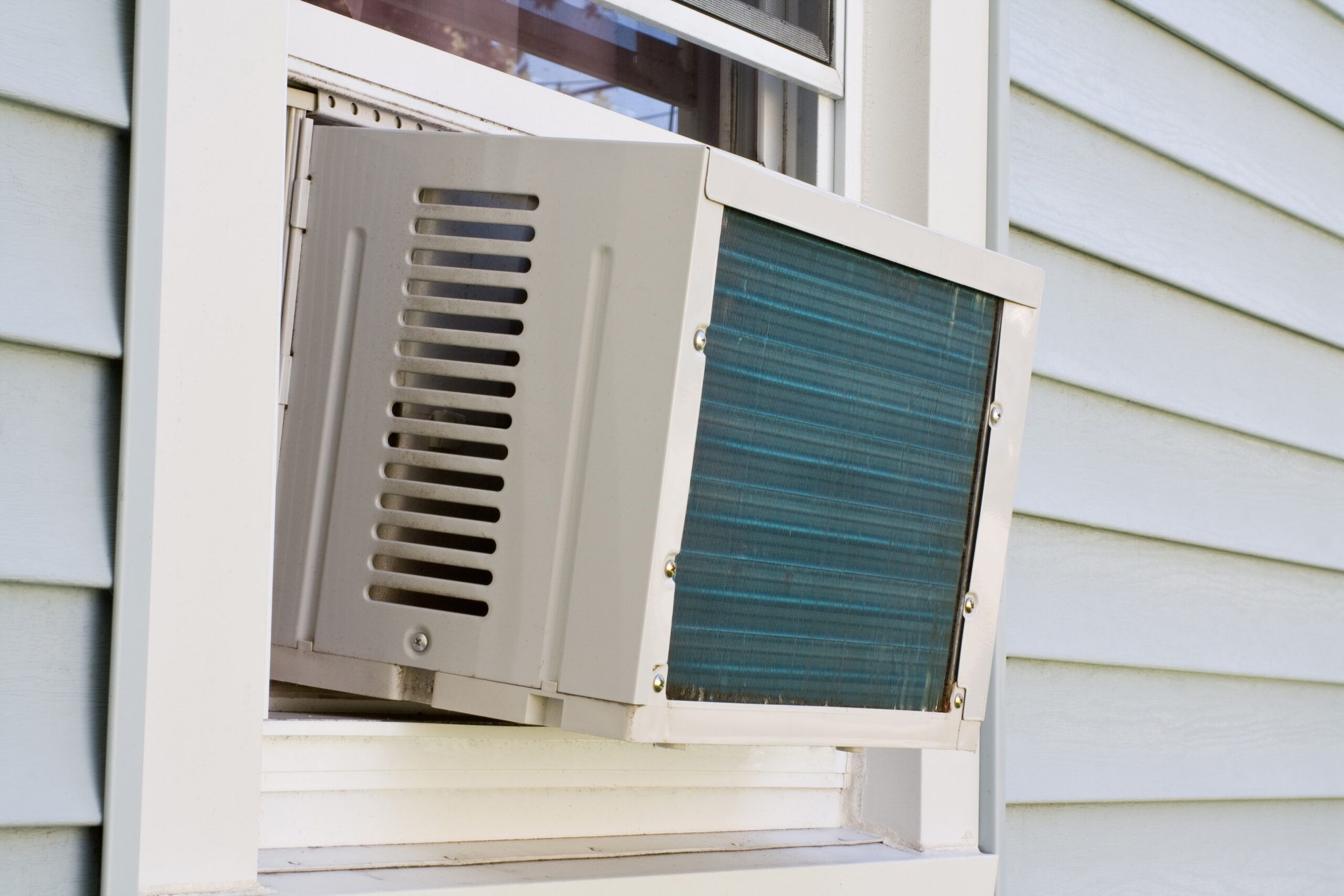
Window AC units do not pull air from outside; they recirculate indoor air while expelling heat and moisture. Window air conditioners operate by taking the room’s existing air, cooling it, and then circulating it back into the space.
Empowering your home with a comfortable climate, window AC units are a staple for temperature control during warmer seasons. These appliances harness the power of refrigeration to transform warm indoor air into a cooler breeze, ensuring your living space remains a sanctuary against the heat.
Traditional window air conditioners are self-contained systems designed to service the room in which they are installed, emphasizing energy efficiency and space-saving convenience. As an integral part of modern living, they strike a balance between functionality and cost-effectiveness, making them a popular choice for immediate cooling requirements, especially in areas where central air conditioning systems are impractical or too expensive to install.

Credit: www.amazon.com
The Mechanics Of Window Ac Units
Understanding how window AC units work is key to maximizing their efficiency. They chill indoor spaces not by pulling in fresh air from outside, but through a clever process involving several components. Let’s explore what goes on behind the controls of these compact cooling machines.
Key Components Involved
In a window air conditioner, key parts team up to cool the air:
- Evaporator – Absorbs heat from inside the room
- Compressor – Elevates refrigerant temperature
- Condenser – Gives off heat to the outdoors
- Fan – Circulates air over the evaporator and condenser coils
- Refrigerant – Transfers heat from inside to outside
- Expansion valve – Regulates refrigerant flow
Air Circulation Process
The air circulation process in window ACs is a closed loop:
- Room air gets drawn in and passes over the evaporator coil.
- The coil absorbs heat, cooling the air.
- The now-warm refrigerant moves to the compressor.
- It gets hotter as the compressor squeezes it.
- This hot refrigerant travels to the condenser.
- Outside air helps dissipate the heat from the condenser.
- The refrigerant cools down and returns inside through the expansion valve.
- The cycle repeats, keeping the room cool.
This system efficiently recycles indoor air, rather than pulling in outdoor air. It provides a consistent temperature control within your space, maintaining cool comfort.
Myths Vs. Facts: Understanding Airflow
Welcome to “Myths vs. Facts: Understanding Airflow,” where clarity meets comfort.
In this enlightening section, we debunk common misunderstandings. Let’s separate fact from fiction surrounding window AC units.
Misconceptions Surrounding Window Acs
Do window AC units bring in outdoor air? A prevalent question with a straightforward answer: no. The myth persists that window air conditioners pull fresh air from outside, mixing common assumptions with the reality of how AC units truly function.
- Window ACs recycle air: They cool the indoor air.
- No outdoor air exchange: They do not replace indoor air with outdoor air.
- Insulation is key: Proper installation prevents outside air from seeping in.
How Ac Units Really Work
Understanding the principles of window AC units is essential. They operate on a closed loop system. This system involves several core components:
- The evaporator: Absorbs room heat.
- The compressor: Pumps refrigerant.
- The condenser: Releases absorbed heat.
- The fan: Recirculates the cooled air.
The truth is, these devices focus on cooling and recirculating the air already inside your space. They extract heat from the indoor air and discharge it outside. A process that enhances your indoor comfort. Fresh air intake typically doesn’t factor into their operation unless specifically designed to do so.
Comparing Window Ac To Other Systems
An important choice for home comfort comes down to selecting the right air conditioning system.
Window AC units are popular for their ease of installation and cost efficiency, but how do they stack up against other systems?
Dive into the comparison and decide which may be your home’s best bet.
Central Air Conditioning
Central air systems distribute cool air through a network of ducts and vents.
- Cools entire home consistently
- Energy-efficient for large spaces
- Quiet and out of view
- Requires professional installation
- More costly upfront
Portable Air Conditioners
Portable ACs can be moved from room to room, offering flexibility.
- Ideal for spot cooling
- No installation needed
- Visible and may be noisier
- Vents through a window
- Limits obstruction of window views less than window AC units

Credit: www.thisoldhouse.com
Evaluating Air Quality And Exchange
Understanding the relationship between window AC units and air exchange is pivotal for maintaining a healthy indoor environment. Different AC units function in varied ways affecting air quality. Let’s evaluate air quality and exchange in the context of window AC units.
Indoor Air Quality Considerations
Air quality indoors plays a crucial role in health and comfort. Factors such as pollutants, allergens, and humidity levels come into play. Window AC units have a direct impact on these variables. To maintain clean indoor air, we must understand the mechanisms AC units use for air circulation.
- Filtering capacity of the AC unit
- Presence and effectiveness of any built-in air purification systems
- Potential for indoor air to become stagnant
Regular maintenance, including filter replacements and cleaning, is vital. This ensures the AC unit contributes positively to indoor air quality.
Does Fresh Air Enter Through Window Ac?
Many believe window AC units bring in fresh air from outside. In reality, most window ACs recirculate indoor air. They do not have a dedicated mechanism to draw in fresh external air:
- They cool the air inside by passing it over coils.
- Fresh air involvement is minimal or non-existent.
However, some models with ventilator modes can introduce a limited amount of fresh air. If fresh air intake is a priority, consider units with this feature. Be mindful that such units may impact energy efficiency.
Keeping windows slightly open can help introduce fresh air. This complements the window AC’s operation but also must be balanced with contamination risks and the unit’s efficiency.
Enhancing Effectiveness Of Window Ac Units
Window air conditioning units are popular and affordable options for cooling. Understanding how to maximize their efficiency is key. This section provides practical tips for getting the best performance out of your window AC unit.
Regular Maintenance Tips
Maintaining your window AC helps it run smoothly. Follow these steps:
- Clean or replace the air filter monthly.
- Inspect cooling coils for dirt and clean them.
- Check the seal between the AC and the window to avoid air leaks.
- Ensure the drainage system isn’t blocked to prevent water damage.
- Verify that the thermostat operates correctly.
Improving Indoor Ventilation
To improve air flow, follow these guidelines:
- Open windows when it’s cooler outside to let fresh air in.
- Use exhaust fans in kitchens and bathrooms.
- Ensure vents and air intakes are not obstructed.
- Consider using ceiling or oscillating fans to circulate air.
By enhancing indoor ventilation, window AC units work more efficiently. This reduction in strain can lead to lower energy bills and a longer lifespan for your AC.

Credit: www.nytimes.com
Common Questions And Expert Answers
Common questions about window AC units often gravitate towards understanding how they operate. A frequent concern is whether these units pull air from outside. Expert answers can clarify this topic and provide useful insights into the workings of window AC units. Let’s explore what professionals have to say and some expert tips for optimal use.
Expert Tips For Optimal Use
To ensure your window AC is running efficiently, keep in mind the following:
- Clean the filters regularly – Dust accumulation can hinder performance.
- Seal openings – Ensure no external air infiltrates through gaps.
- Set the right temperature – A moderate setting saves energy and maintains comfort.
- Use in appropriate sized rooms – Window ACs are designed for specific room sizes.
- Consider the unit’s placement – Place it away from heat sources for better cooling.
Addressing Consumer Concerns
Consumers often wonder about the source of air in their window AC units. Here’s a breakdown:
- Recirculating Indoor Air – Primarily, window ACs cool the indoor air and recirculate it.
- Exchanging Heat – The hot air from the room is expelled outdoors through the unit’s vent.
- Minimal Outdoor Air Exchange – A small amount of fresh air can be introduced if the AC has a vent feature.
Ensuring tight seals around your window AC unit will prevent drawing in outside air unnecessarily. It will also maintain your room’s temperature effectively.
Frequently Asked Questions Of Do Window Ac Units Pull Air From Outside
Do Window Ac Units Use Outside Air?
No, most window AC units do not use outside air. They recirculate the inside air, cooling it as it passes through the system. The unit exchanges heat with the outside air, but doesn’t typically draw it into your home.
Can Window Ac Affect Indoor Air Quality?
Yes, if not maintained properly, window AC units can affect indoor air quality. Dirty filters or coils can harbor mold and allergens. Regular cleaning and filter changes are essential to maintain good air quality.
How Does A Window Ac Unit Function?
A window AC unit functions by drawing in warm room air, cooling it by passing it over an evaporator coil, and then blowing the cooled air back into the room. It expels the heat outside through the condenser coil.
Is It Necessary To Vent A Window Ac?
No, venting is not necessary for a window AC. These units are designed to vent through the sides and back directly to the outdoors. Proper installation ensures adequate ventilation for heat exchange.
Conclusion
Wrapping up, it’s clear that window AC units do not draw air from outdoors. Instead, they recirculate indoor air, keeping your space cool and comfortable. Remember this vital fact as you consider your home cooling options. Stay informed, stay cool, and choose wisely for your comfort needs.




















